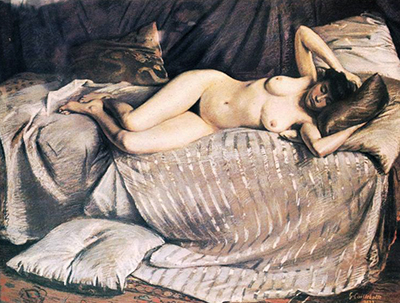Gustave Caillebotte was a highly skilled draughtsman and most frequently he used charcoal and pastels for his drawings which were completed to various levels of detail, with some being study sketches and others being fully fledged independant artworks.
The examples found in this section detail the variety of Caillebotte drawings that have been uncovered from his career. The main photograph captures a beautiful pastel drawing that was delivered to an impressive level of detail, its full title is Naked Woman Lying on a Couch. The Impressionists were generally highly skilled as draughtsmen, and produced large amounts of work in preparation for this, with Caillebotte being no exception. See some of Monet's drawings, for example.
The majority of the drawings uncovered from his career are sections of larger paintings, perhaps experimenting with a particular figure or couple of figures within an overall scene. The complexity of the human anatomy ensures that it is hard for artists to get precisely the look that they are after without considerable amounts of practice. Even the likes of Michelangelo and Leonardo da Vinci would spend endless amounts of time sketching limbs, torsos and facial features in order to improve their skills as draughtsman. Caillebotte was like minded in that regard, though he perhaps didnt go into quite as much detail as them.
The Art Institute of Chicago owns a number of drawings by Gustave Caillebotte, including a study piece for Paris Street, Rainy Day from 1877 as well as a complete sketchbook also from around this period in his career. Many artists would carry around sketchbooks on their person in order to produce work whenever the urge struck them. One could not carry around all the equipment for painting so easily, obviously, and so this was an excellent alternative. In some cases artists would produce a series of drawings when travelling and then develop these into oil paintings once they had returned to the comfort of their own studios. Turner famously did this during his studies of the European landscape.
Perspective was a key element to the work of Caillebotte, particularly when depicted the architectural beauty of Paris. This would always require an attention to detail or risk producing mistakes that even the most amateur of eyes would be able to spot. He would draw first onto his canvas before covering with oils as well as earlier practicing different angles on smaller pieces of paper, perhaps again from his sketchbooks. Another aspect to his sketchbooks was the use of watercolour, a medium that he enjoyed but also required continual practice in order to match the qualities of his work with oils.




